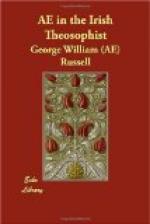H.P. Blavatsky translates this word as Be-ness,
which seems to be another way of expressing the same
idea. The mystic incantation familiar to all
students of the Upanishads, Om, bhur, Om, Bhwar, Om,
Svar,” is an assertion of the existence of the
Divine Self in all the three worlds or Lokas.
Loka is generally translated as a place; the letters
suggest to me that a place or world is only a hardening
or crystalization of Fire or Light. In Bhur Loka
the crystalization of the primordial element of Fire
leaves only one principle active, the life principle
generally called Prana. Bhur Loka then is the
place where life is active; we have B, life, and
R, movement, to suggest this. In the word Bhuvar
a new letter, V, is inserted: this letter, as
I have said, corresponds to the Astral world, so the
Bhuvar Loka is the place where both the Astral and
Life principles are active. It is more difficult
to translate Svar Loka: there is some significance
attached here to the letter S, which I cannot grasp.
It might mean that this world contains the germs
of Astral life; but this does not appear sufficiently
distinctive, Svar Loka is generally known as Devachan,
and the whole incantation would mean that the Deity
is present throughout the Pranic, Astral and Devachanic
worlds. It is interesting to note what is said
in the Glossary by H.P.B., about these three words
(p. 367): they are said to be “lit by and
born of fire,” and to possess creative powers.
The repetition of them with the proper accent should
awaken in the occultist the powers which correspond
to the three worlds. I think by these examples
that the student will be able to get closer to the
true significance of incantation; those who understand
the occult meaning of the colours attached to the
letters will be able to penetrate deeper than others
into these mysteries.
I may here say something about the general philosophy
of incantation. There is said to be in nature
a homogenous sound or tone which everywhere stirs
up the molecules into activity. This is the “Word”
which St. John says was in the beginning (the plane
of causation); in another sense it is the Akasa of
occult science, the element of sound, it is the Pythagorean
“music of the spheres.” The universe
is built up, moulded and sustained by this element
which is everywhere present, though inaudible by most
men at this stage of evolution. It is not sound
by the physical ears, but deep in the heart sometimes
may be heard “the mystic sounds of the Akasic
heights.” The word Aum represents this
homogeneous sound, it stirs up a power which is latent
in it called the Yajna. The Glossary says that
this “is one of the forms of Akasa within which
the mystic word calls it into existence:”
it is a bridge by means of which the soul can cross
over to the world of the Immortals. It is this
which is alluded to in the Nada-Bindu Upanishad.
“The mind becoming insensible to the external
impressions, becomes one with the sound, as milk with




